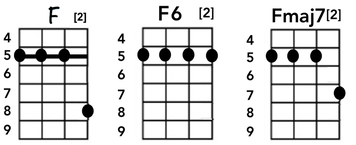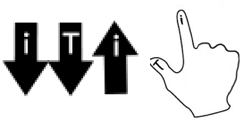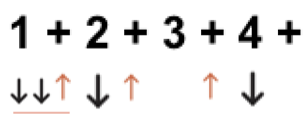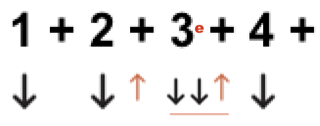MODULE 1
KEY COMPONENTS
It's important to understand the key components of the song before you get started so that you know what to aim for when practicing.
TIME SIGNATURE: 4/4
TEMPO: 115BPM
KEY: F
TEMPO: 115BPM
KEY: F
Playing this song in the key of F major is a great key for picking out that melody line during the chorus sections and solo. If you find it difficult to sing along in this key, you can always change keys later, or slap on a capo and play the same patterns higher up the neck. If you are unsure about how to change keys, click on the button below to download a KEY SIGNATURE CHART and essential information on HOW TO CHANGE KEYS.
THE CHORDS
This wonderful arrangement contains a huge variety of chords including: MAJOR, MINOR, SEVENTHS, SIXTHS, NINTHS, MAJOR 7ths, MINOR 7ths, MINOR 6ths and DIMINISHED 7ths.
Don't panic if there are some chord names you haven't heard of, they're not as tough as they sound, although a little bit of finger yoga may be required for that Fmaj7 in the intro.
To see how chords are constructed, click the button below to download a chord construction chart with examples of how to play all of the shapes in rooted in C.
Don't panic if there are some chord names you haven't heard of, they're not as tough as they sound, although a little bit of finger yoga may be required for that Fmaj7 in the intro.
To see how chords are constructed, click the button below to download a chord construction chart with examples of how to play all of the shapes in rooted in C.
OPEN CHORD SHAPES
Most of these chords can be played in open position in the bottom 4 frets of the ukulele, with a few barred chords to assist as follows:
VIDEO TUTORIAL
EXTRA CHORD SHAPES
There is a few extra chords not stated on the song sheet and a few alternative chord positions to play during the solo. These chords come into play when picking out the melody and include a G7sus2, a Dsus2, an E7 in 2nd position, barred at fret 4, an E Major barred at fret 4 and a Dm in 2nd position at fret 5 as illustrated below.:
ALTERNATIVE INTRO CHORDS
There is also an alternative way to play the introduction section. Start with the F major chord barred at the 5th fret and the pinky on the A string of fret 8 as illustrated below. For this sequence, you can replace the Dm with an F6 chord by simply barring across fret 5. The F Major 7 is also barred across fret 5 with the addition of the 3rd finger on the A string of fret 7:
Have a listen to the audio below to hear what this alternative playing position sounds like:
STRUMMING TECHNIQUES
There are a number of strumming techniques used throughout this arrangement that will really make this song come alive, including; dampening, thumb rolls and a pluck 'n' strum technique that will have you combining the melody with the chords for the solo section.
DAMPENING TECHNIQUE
The dampening technique can also be referred to as ‘choking’ or 'left hand muting' and basically has you cutting off the tail end of a chord or note once struck to give it a snappier 'STACCATO' effect. To help you spot where this technique appears, the arrows representing the dampened beats will have a dotted thin line underneath them as illustrated below:
Download the PDF by clicking on the button below for written instructions on a variety of ways to get that dampened technique down and watch the video below for examples.
VIDEO TUTORIAL
THUMB ROLL TECHNIQUE
This technique, also known as 'triplet strumming', is a fantastic way to make your songs sound more creative and once you get to grips with it, I imagine you will use it much more. This triplet stroke requires the use of both the thumb and index finger as illustrated below and appears in strumming patterns as smaller arrows with two black down strums and one red up strum, all underlined, as illustrated below:
Download the PDF by clicking on the button below for written instructions on how to achieve the Thumb Roll and then watch the video below to try some exercises that will come in handy for when you are practicing the song.
VIDEO TUTORIAL
PLUCK & STRUM TECHNIQUE
As mentioned above, the solo section of the song combines chords with a melody line. To achieve this, you will explore a pluck and strum technique. This section will be illustrated with numerical tab and arrows, like the example below, along with the chord symbols above the tab to help with plucking positions.
Watch the video below for a step by step guide on this technique.
VIDEO TUTORIAL
10%
Now you have the basic elements of the song in your mind, it's time to get started on the arrangement which will be broken down into sections, so click the button below for the next module, which will help you to explore the intro section in two positions.








